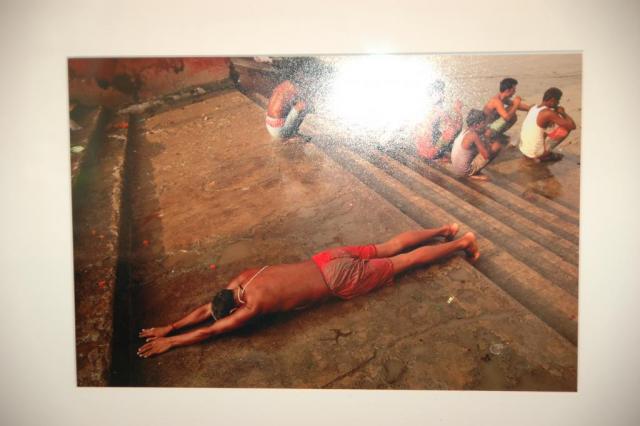Over the past week, some of our Evanston Art Center interns interviewed an artist from our Evanston Made Exhibit that caught their eye.
Learn more below about: Vanessa Filley, Stephen Murphy, Kristen Neveu, Jevoid Simmons and Dorit Jordan Dotan.
First is an interview with Lisa Degliantoni, the creator of Evanston Made.
How did Evanston Made start, what was the inspiration for the project?
Many other cities and neighborhoods host artist studio tours and we just copied them! Evanston has one of the highest populations of artists in a city of its size, so it was really easy making that first list of artist studios - building attendance has been the challenge. This event started June 2013, and in it's third year has grown to host more than 75 visual artists.
We used to be called Open Studios Evanston but given the name collision with Open Studio Project, we changed it to Evanston Made in 2016. Jaime Leonardi designed an adorable logo and we created stickers, tee shirts and postcards to promote the new name.
What would you define the organization as (ex; non-profit, community engagement, etc.)?
Evanston Made is a community engagement initiative started by Evanston citizen and arts advocate, Lisa Degliantoni (me!). As the Evanston Arts Council Co-Chair, I have a insider knowledge of what visual artists need in terms promotions and support, so this volunteer project has been a natural extension of my interests.
What are the current goals of Evanston made?
Create opportunities for Evanston-based artists of all levels to engage with the community. (and vice versa)
How was this year different, how did it grow into a month long show?
There has always been a big demand to see artist's work before the public visited the studio, not just see it online. We hosted a show for the weekend at Noyes Cultural Center which allowed people to preview works by artists on the studio tour, it was a tremendous amount of work for one weekend.
This year we expanded the invite to include any artists living or creating works in Evanston, and needed a much bigger space with longer display time. Evanston Art Center was an ideal partner, able to display more than 106 individual 2D/3D works on the first floor alone and willing to keep the work up for a month. If people missed the studio tour, they had a chance all month to see the works and save the date for next year's tour.
We also were able to invite many more artists to participate by partnering with AnoMAly Production on the Pop UP Shop in the lobby. Many artists don't fit in the 2D/3D category (jewelry designers, leather goods, etc.) and a Pop Up Shop allowed us to expand the invite list. We're hosting almost 150 artists at Evanston Art Center. No other venue in Evanston can support that volume of creatives.
Thirdly we added a kids event, Evanston Made Kids! that allowed families the chance to visit the Evanston Art Center, and see works on display and shop at the kid's bazaar - featuring works by creative kids! This event was really well attended and the event producers Bon Events, gathered a very enthusiastic team of volunteers that made the event very family friendly.
The Evanston Art Center was a tremendous partner for Evanston Made and Paula, Gabrielle, Cara, Larry and Jason made it incredibly easy to produce this multilayered event, affording artists to show work for the 1st or 50th time. The range and volume of works is impressive. And the range of programming the Center hosted afforded attendance to all ages and backgrounds.
Vanessa Filley
Interviewed By: Madison Linnen
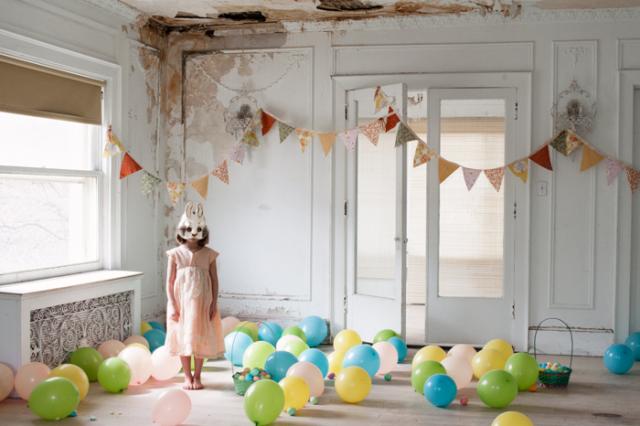
Where do you get your inspiration from?
From a passing interaction with a stranger, from meeting a new friend and learning about her art, from fairytales, childhood nursery rhymes, books, from a dream that wakes me frantic to scribble down an image before it flits away, from wandering through allies and spotting an old couch, a mattress, a chair, a painting, a garage with crumbling paint, from the opportunity to use an architecturally interesting space, from wandering through the crowded aisles of a local prop shop basement, from studying artists and makers who have come before me and those who are making now, from personal and family history, from a longing for the past, romantic lore, from the pain and darkness of current events or life experience, my own or others, from conversations with my children, from an understanding that it is too easy to get sucked into a vapid digital world and that it takes committed and daily work to feel alive and connected to one’s own creative self and others, from a need to try on different voices and stories in a search for a sense of greater connection.
Do you have a favorite theme you like to capture through photography?
Hmmm, I think it depends on the day, the moment. I’m intrigued by the unknown within an image, it’s telling a story, but not the whole thing. How can I make images that make people want to return to them, ask questions, enter a space of wonder and create their own narrative. But a search for mystery and narrative isn’t necessarily my theme. I’m interested in the relationship between humans and animals, between the past and the present and I have a certain love of botanicals and old spaces with a sense of a story. I’m steeped in childhood and memory and the way the young mind perceives, imagines and experiences. I’m compelled by the fragility of it all. I’m a little obsessed with how we access our imaginations, be it through boredom or dreams and all that is possible if we allow ourselves to go deeply into the recess of our own unknown. Those maybe are some of my current themes.
How long have you been doing photography?
I've loved making pictures for many years. I remember when I was on assignment for (unrelated) work in Montgomery Alabama 15 years ago and the Alabama National Fair was happening. After a grueling day of work I went to shoot the fair at night. I had such a strong vision in my head of what those images should look like, but given that I knew next to nothing about how to make a picture other than point and shoot, those images failed to meet my expectations. I always had a camera as a kid and documented the passage of time, but over the last decade I have gotten to know cameras and manual functions much more intimately. I've fiddled my way into being able to dream up an image and sometimes, if I'm lucky, bring it into being.
Does the story come before or after the photograph?
It depends on the project. Sometimes opportunities to make pictures arise and I have no idea what the images could possibly be until I'm in the moment looking through the view finder and only after the fact do I see if I was able to capture anything that might speak to somebody other than me. But right now I'm very focused on creating images that I've meditated on and conjured up from a seed and worked toward over a period of time, some times a day, sometimes months. Most of the series I am currently working on are sparked by an idea that comes to me. I jot it down in a journal as a sort of descriptive poem--the story. From that I make notes on where an image might be shot, who might be in it, what they are wearing/holding/doing. Then I have to map out what I have to do to bring the image into being from sourcing tens of 1930's composition dolls to making a dress for a unicorn queen. On the journey from the inspiration to the actual making, the story evolves. Sometimes after a photograph is made my actual language around it might change as I reflect back on it and try to see it through new eyes, or if it is slightly different than what I might have imagined, but still matches the vision, the story might subtly be adjusted.
Do you use different forms of art and crafting to portray different stories/ideas?
I do. I have been a maker of a sort since I was little. As a child my mother sent me to learn to make doll clothing by hand from a friend of hers. This was a magical moment when I figured out that I could see something in my head and then actually make it a reality. In my younger years poetry and dance were my primary modes of creative expression. That has evolved over the decades and become interwoven into my various makings. At this point the vision of what I want to make comes first and then I have to figure out how to do it. Often new skills are needed, be it learning how to work with non-toxic resins or lighting a space. Over the years I’ve delved into letterpress, watercolors, encaustics, botanicals, photography, embroidery and fiber arts in many forms, these methodologies get mixed together and build upon each other to make any given piece. At present my work focuses on building sets, gathering and arranging objects, making costumes and props and then putting it all together and hoping the magic moment of natural light and emotional expression align. I’m learning to perfect my drafting and sewing skills, attempting to not destroy vintage wallpapers while attaching them to surfaces and mostly learning patience and trying to practice a little bit of non-attachment, if it doesn’t work out the first time it’s okay, sometimes maybe the piece wasn’t meant to be or maybe I just need to try again. When I began focusing my work more heavily in photography I realized I was starting to feel a little sad and empty, missing the act of physically making something with my hands. I was conjuring ideas, location scouting, costuming and editing images, but I felt a certain emptiness. I kind of hate the computer and am desperate not to focus my work on post-production. With this emotional voice needing to be satisfied I began more vigorously making objects and attire that go into my images. I am hungry to get back to a deeper practice of quiet hours in my studio of meditative making, but for the moment that’s on the back burner as I splice together a little bit of physical making with all the other parts that go into building an image.
Stephen Murphy
Interviewed By: Anna Weeks
Who is your favorite artist/photographer and what about them and their work captivates you?
This is a very difficult question to narrow down to 'one' favorite...there are so many...I enjoy documentary work and conceptual work. I am a big fan of 'street photography'--the work of Gary Winogrand, Lee Friedlander, Helen Levitt, etc. The piece in the show is from a street photography workshop in Kolkata. It was led by a famous photojournalist, Peter Turnley. The man who is prone in the photo is doing his morning devotion after bathing in the river. The men in the background are 'brushing their teeth' with a twig from a special tree that fights decay.
What is your favorite subject to photograph?
I don't really have a favorite subject either. The scene has to interest me because of what is going on, the light, the compositional elements that I gather in the viewfinder.
What do you want people to take away from your work?
For any of my pieces--and there is a lifetime of work now since I have been shooting since high school, went to an art school and majored in photography, and then taught photography to all levels in high school--it is enough for me that someone takes the time to pause and really look at the work. That is quite an achievement in this day and age where everyone is shooting and sharing photographs everywhere.
In the age of smartphones and social media some would say everyone is a photographer, do you agree?
Well, perhaps everyone may be able to 'take a picture' but only few are able to 'make a photograph'. I just got off Facebook today and for the life of me I cannot understand why people post such bad pictures. There is sooo much stuff shared on Facebook that makes me cringe--blurry, unedited series of the same people in almost the same pose/place--WHY??
In every case I gently edit anything I post--contrast, color, etc.--should it need that boost-- and share if i think it is interesting. for a while i was posting ' Dogwalk Diptychs' of what i see on our walks. may make a book of same. So, no, i certainly don't think everyone is a photographer, though many many folks have camera phones. no more so than in the past pre-smartphone age, not everyone who had a SLR or a DSLR was a photographer.
What advice would you give to me as an aspiring photographer?
Look at the masters of the medium; absorb them into your visual vocabulary. emulate them and find your own visual voice. Be kind. Be compassionate. Never finger point. Shoot shoot shoot what comes naturally to you. And as I told my students time and time again--get in closer!!! Shoot the heck out of a situation where you sense a photo in the making & change your point of view while doing same. And I would tell my students, cropping is for farmers--visualize the scene in the viewfinder. that is what it is for. If you find what really interests you is in the middle of the frame--get in CLOSER.
Kristen Neveu
Interviewed By: Katherine Hillesland
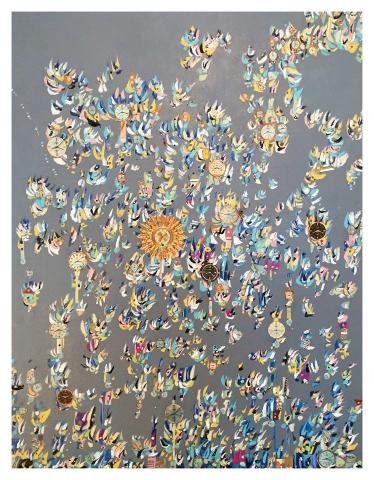
What inspires your artwork?
My artwork in inspired by day-to-day everyday routines and passing of time, and the patterns of nature in relation to time movements.
What inspired Silver Pearl Time Slip, your piece featured in the show?
Silver Pearl Time Slip is inspired by my grandmother who had Alzheimer’s for many years. I didn’t get a chance to know her very well because she started to become ill when I was a teenager and we didn’t always live close by for visits. I regret this. She was an elegant lady and I remember lots of jewelry and a collection of china teacups.
How long does it take you to finish a mixed media collage?
I have a full-tie day job and I do my artwork in the evenings. Depending on the size, one of my pieces can take anywhere from 1-2 weeks to create. I have a drive to create; I don’t watch television, and if I’m not socializing in the evenings then I’m home in my studio.
How long have you been selling your art?
I’ve been selling and creating my art for about 17 years.
What is your favorite part about being an artist?
My favorite park of being an artist is the freedom you have to create anything that inspires you. You can heal yourself through art.
Jevoid Simmons
Interviewed By: Leah Imani Spears
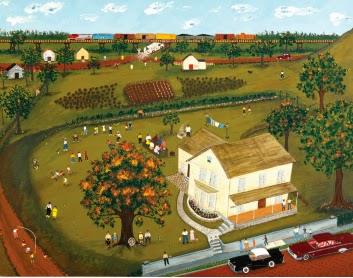
What inspired you to use your family as a medium for this art series?
This has been an on going project for 8 years, and I wanted to share my father’s story about this Great Migration of coming north. I felt this was important to share to help the younger generation understand the importance of knowing where you’re from and to know where you’re going.
Has your family inspired you in you other art pieces? How so?
I am very family oriented so yes, this I have this painting series and many wooden carvings I have made of almost all my family members.
Does a lot of your other artwork tell a story? What are some examples?
Yes. In order to gain knowledge we must tell stories of our past and of real people to have our future flourish, as well as to stress the importance of family.
What message are you trying to convey in your visual novella (purpose, the "so what?", the "why should we care?")
My purpose is to share my family’s story, and by doing this to teach and encourage young people to look at the past and to utilize the future. I want to give perspective to the younger people.
What are some other ways do you convey this message in your art making process?
I produce a lot of art work that gives a sense of nostalgia. I use a lot of folk art to capture things of the past and I design game boards that focus on history.
Having grown up during a time of explicit prejudice and bigotry, do you believe things have started to get better/worse/stayed the same?
To me it feels like we’re in a position where we are confident, we are constantly moving forward but also moving backwards, almost like a pendulum. I believe that humans do not know who the enemy is, so we blame human nature instead of acknowledging the real core of this issue with prejudice.
What do you hope your audience will gain from reading this visual short take?
I hope that people will get to understand one another by sharing who they are, bringing each other together and having the older generation share their stories with the younger generation.
Being an aspiring artist of color, what advice could you give me as I continue to get a higher education in the arts?
I advise to you find your passion. Remember that meaning and making are inseparable. Always have a purpose in your art, find out the “why” and always work from the heart.
Dorit Jordan Dotan
Interviewed By: Emily Coplan
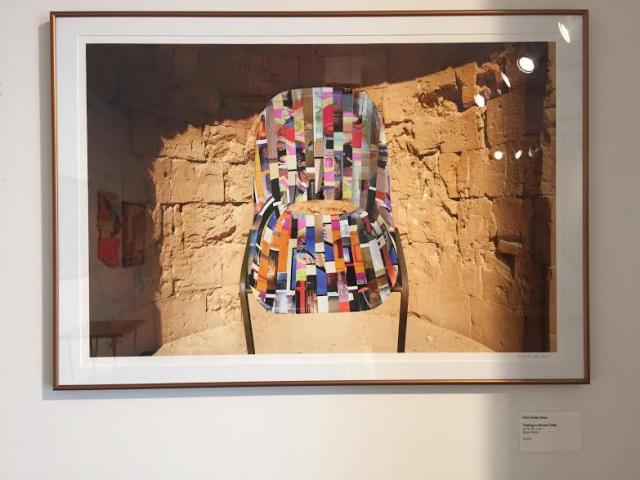
Why did you choose to work with mixed media for this piece?
The idea behind the series is to represent the materials that degrade over time, and to connect the past to the present. The background is a photograph of an ancient Nabatean site in the southern Israeli desert. The place was used thousands of years ago as a camel caravansary and trading hub along the Spice Road. I created the chair from found materials that had been thrown out. Materials that aren’t found in nature get used in new ways and for new purposes. The materials used all those thousands of years ago were found in the world around them, are still standing, they were meant to last forever. We need to be reminded that the materials we use should come from what’s around us, and should be able to stand the test of time. Today, in a society of plenty and consumerism, using materials that are considered garbage in new and unintended ways is something I try to do regularly. The industrial consumer economy tries to persuade us to constantly buy new, but at a level of quality that forces you to repeatedly buy new rather than repair and re-use the old. I would hope that those looking at my work will be impressed by the idea that re-using and recycling and re-purposing is crucial to reducing the damage massive industrial production has caused.
While looking at your other work, I was drawn to your photographs of the Peace Puppets. How do you think art plays a role in encouraging peace?
Art, and artists in general, have a very important role in presenting processes for peace, human rights and equality. Through art, there is an opportunity to express ideas visually, and to allow conversations and communication without the need to “defend” your ideas, without the need to become rigid with your opinions. You’re not speaking for a political party, and that makes it much easier to for the viewing public to accept new ideas. I think that artists in all media need to commit themselves to social change. Art isn’t threatening, and artists have the freedom to present other ways of cooperation, and especially alternative way of seeing. The “Peace Puppets” series is part of the work of long-term non-profit activist organization that I have been documenting for some years. Combatants for Peace is a cooperative group of Palestinians and Israelis who previously had all been combatants on either side of the conflict, who have all foresworn their weapons. Now they are “fighting” for peace, through creative art and actions of cooperative activism within both Israel and the Palestinian Territories. They invite the general public for tours, and to create these huge puppets which can tower over any walls to see the other side. They organize meetings on both sides of the Separation Wall, in order to encourage peaceful dialog among all parties.
How does photographing in Chicago differ from photographing in Israel? Do your goals change in different places?
Chicago’s urban space is very different from Israel. The buildings and skyscrapers and the architecture fascinates me, and I love to wander the city streets, taking pictures of buildings and stores, especially with all of the art deco! Chicago is a visual feast, it’s a beautiful place to see very large things, and also very small, unnoticed things. Evanston is perfect, the homes and the urban art and the gardens and the parks, lake and the people all make me happy, every time I go walking around. And I walk around a lot! I love the rusted bridges of the elevated trains, and all that happens underneath them. I look between the skyscrapers and the elevated trains and look at the tourists, the upper class men and women, the fancy offices and the unseen underclass that exists so invisibly: the immigrants, the homeless, the servers and workers. I also continue to investigate and document the urban human landscape, and to look deeply into those people on the fringes of society. Just like when I’m in Israel, it’s very important to me to photograph images that will encourage people to really see other humans beside them. No matter where I am I try to capture images that are humanly true.
Who is an artist you admire and why?
Judy Chicago is certainly one of them. She created “The Dinner Party” in 1979, and exhibited it in the Museum of Modern Art in San Francisco. It was a woman’s experience of Da Vinci’s “Last Supper”: a huge triangle of long tables, and on each side were 13 women who left their imprint on history. Judy Chicago’s table was set to honor those women who set tables and prepared feasts throughout history, and who were often unrecognized. I became aware of her work only in recent years, when I was honored to exhibit with her in a group shows in New York. Her creations, especially in Jewish art, bring a feminist viewpoint, modern techniques and show fabulous color.
I also am very interested in the work of Vivian Maier. She was a street photographer, and she focused on the people and human interaction around her. She also looked at the invisible people, the ones on the edges of the mainstream. She left a huge body of work. It’s magical, and very fine art.
How has your art changed over time?
During the last five years I have been exhibiting mixed media/photography pieces, mostly in New York. Lately my work has been connected with the Old Testament. I work with a curator at a museum in Manhattan. Before each exhibition she invites artists to create work in line with her ideas for a show. Together over the course of a year, the artists and the curatorial team go on a philosophical journey through an idea or theme of the Old Testament, with modern interpretations. The work is wonderful and every year I am so proud to be part of these group exhibits. In September of this year, two of my mixed media works will appear in “Painted by Numbers”, on the subject of Noah’s Ark and the Flood. As a politically active, secular Jewish Israeli, I get to work along with others who are bringing entirely new perspectives to stories I’ve heard all my life. Each exhibit pushes me to develop new styles, new techniques. The more I’m connected to other artists, the more we feed each other. My documentary photographs were often the result of being in the right place at the right time. Lately I have been focusing more on the underlying social processes that impact human rights. I’m very interested in the demographic changes all around us, and how it changes us; who we feel connected to or isolated from.


